Fatigue Behavior and Fracture Surface Analysis of Corroded High-Strength Bridge Cable Wires
Abstract
1. Introduction
2. Materials and Methods
2.1. Materials
2.2. Salt Spray Test of Steel Wires
2.3. Tensile and Fatigue Tests of Steel Wires
3. Results and Discussion
3.1. Corrosion Performance of Coatings and Steel Wires
3.1.1. Corrosion Appearance Characteristics
3.1.2. Mass Loss Rate and Corrosion Depth of Coatings
3.1.3. Mechanical Properties of Corroded Steel Wire
3.2. Corrosion Fatigue Behavior of Steel Wires
3.2.1. Corrosion Fatigue Life
3.2.2. Fracture Surface Analysis
3.2.3. Fracture Toughness
4. Conclusions
- (1)
- The superiority of the Zn-Al alloy coating in resistance to corrosion fatigue was confirmed by the analysis of the microstructure and salt spray corrosion test. The element Al can improve toughness and corrosion resistance for the generation of denser Zn-Al and Fe-Zn-Al phases. The salt spray resistance of the Zn-Al alloy coating was about twice more than that of the galvanized coating with the same thickness. A two-stage model was developed to evaluate the corrosion ability of the Zn-Al alloy coating, which can reach 29.1 years with a thickness of 70 μm.
- (2)
- The mechanical properties of the bare wires after the salt spray test were further studied based on tensile tests, where the mass loss rates ranged from 0 to 21.38%. The test results show that the Young’s modulus, elongation rate, ultimate strain, tensile strength, and yield strength of the wire decreased as the mass loss rate increased and the most obvious change was in elongation rate. The corrosion effect was mainly manifested in the ductility of the Zn-Al alloy-coated wires, and the ultimate strain gradually decreased with the corrosion degree.
- (3)
- The corrosion fatigue fracture surfaces were analyzed using a high-precision industrial camera and by recognizing graphical contours. Fatigue initiation sites were mostly located near the bottom of the pits rather than at the interface between the pits and the steel wire surface. Insufficient fatigue life may occur in the steel wires used in actual engineering after corrosion for the interaction of fatigue stress and corrosion action. This impact increased with the degree of corrosion. Corrosion fatigue was more sensitive to the existence of fatigue sources than the reduction in the cross-section caused by corrosion. The pit depth logarithmically weakened the fatigue life of steel wires for weakening the fatigue toughness and bearing area. The presence of multiple initiation sources significantly reduced the fatigue life due to the cracking facilitation of the joint effect of multiple pits. The flat fracture was more common with a single fatigue source, while multiple fatigue sources led to step-like fractures for the generation of multiple dispersed crack propagation regions.
- (4)
- Corrosion had a reducing effect on the fracture toughness of the steel wires, which can be described adequately by a linear model. The fracture toughness of the corroded Zn-Al alloy-coated wire was calculated to decrease from 90 MPa·m0.5 at the mass loss rate of 8% to 60 MPa·m0.5 at the mass loss rate of 20%. This is probably because the electrochemical reactions of corrosion can lead to material embrittlement and a decrease in fracture toughness, which should be of concern in the fatigue life evaluation.
Author Contributions
Funding
Institutional Review Board Statement
Informed Consent Statement
Data Availability Statement
Acknowledgments
Conflicts of Interest
References
- Liu, Z.; Guo, T.; Yu, X.; Huang, X.; Correia, J. Corrosion fatigue and electrochemical behaviour of steel wires used in bridge cables. Fatigue Fract. Eng. Mater. Struct. 2021, 44, 63–73. [Google Scholar] [CrossRef]
- Lonetti, P.; Pascuzzo, A. Vulnerability and failure analysis of hybrid cable-stayed suspension bridges subjected to damage mechanisms. Eng. Fail. Anal. 2014, 45, 470–495. [Google Scholar] [CrossRef]
- Karanci, E.; Betti, R. Modeling corrosion in suspension bridge main cables. I: Annual corrosion rate. J. Bridge Eng. 2018, 23, 04018025. [Google Scholar] [CrossRef]
- Guo, T.; Sause, R.; Frangopol, D.M.; Li, A. Time-Dependent Reliability of PSC Box-Girder Bridge Considering Creep, Shrinkage, and Corrosion. J. Bridge Eng. 2011, 16, 29–43. [Google Scholar] [CrossRef]
- Ma, Y.; Wang, G.; Guo, Z.; Wang, L.; Jiang, T.; Zhang, J. Critical region method-based fatigue life prediction of notched steel wires of long-span bridges. Constr. Build. Mater. 2019, 225, 601–610. [Google Scholar] [CrossRef]
- Suzumura, K.; Nakamura, S. Environmental factors affecting corrosion of galvanized steel wires. J. Mater. Civ. Eng. 2004, 16, 1–7. [Google Scholar] [CrossRef]
- Nakamura, S.; Suzumura, K. Experimental study on repair methods of corroded bridge cables. J. Bridge Eng. 2012, 17, 720–727. [Google Scholar] [CrossRef]
- Jeong, S.; Lee, Y.J.; Shin, D.H.; Sim, S.H. Automated real-time assessment of stay-cable serviceability using smart sensors. Appl. Sci. 2019, 9, 4469. [Google Scholar] [CrossRef]
- Fu, Z.; Ji, B.; Yang, M.; Sun, H.; Maeno, H. Cable replacement method for cable-stayed bridges based on sensitivity analysis. J. Perform. Constr. Facil. 2015, 29, 04014085. [Google Scholar] [CrossRef]
- Molnár, V.; Fedorko, G.; Krešák, J.; Peterka, P.; Fabianová, J. The influence of corrosion on the life of steel ropes and prediction of their decommissioning. Eng. Fail. Anal. 2017, 74, 119–132. [Google Scholar] [CrossRef]
- Santos, T.F.A.; Vasconcelos, G.C.; De Souza, W.A.; Costa, M.L.; Botelho, E.C. Suitability of carbon fiber-reinforced polymers as power cable cores: Galvanic corrosion and thermal stability evaluation. Mater. Des. 2015, 65, 780–788. [Google Scholar] [CrossRef]
- Iordachescu, M.; Valiente, A.; De Abreu, M. Damage tolerance and failure analysis of tie-down cables after long service life in a cable-stayed bridge. Eng. Fail. Anal. 2021, 125, 105437. [Google Scholar] [CrossRef]
- Roffey, P. The fracture mechanisms of main cable wires from the forth road suspension. Eng. Fail. Anal. 2013, 31, 430–441. [Google Scholar] [CrossRef]
- Li, R.; Miao, C.; Yu, J. Effect of characteristic parameters of pitting on strength and stress concentration factor of cable steel wire. Constr. Build. Mater. 2020, 240, 117915. [Google Scholar] [CrossRef]
- Betti, R.; West, A.C.; Vermaas, G.; Cao, Y. Corrosion and Embrittlement in High-Strength Wires of Suspension Bridge Cables. J. Bridge Eng. 2005, 10, 151–162. [Google Scholar] [CrossRef]
- Furuya, K.; Kitagawa, M.; Nakamura, S.-i.; Suzumura, K. Corrosion Mechanism and Protection Methods for Suspension Bridge Cables. Struct. Eng. Int. 2000, 10, 189–193. [Google Scholar] [CrossRef]
- Li, S.; Xu, Y.; Li, H.; Guan, X. Uniform and Pitting Corrosion Modeling for High-Strength Bridge Wires. J. Bridge Eng. 2014, 19, 04014025. [Google Scholar] [CrossRef]
- Lan, C.; Xu, Y.; Liu, C.; Li, H.; Spencer, B.F. Fatigue life prediction for parallel-wire stay cables considering corrosion effects. Int. J. Fatigue 2018, 114, 81–91. [Google Scholar] [CrossRef]
- Guo, T.; Liu, Z.; Correia, J.; De Jesus, A.M.P. Experimental study on fretting-fatigue of bridge cable wires. Int. J. Fatigue 2020, 131, 105321. [Google Scholar] [CrossRef]
- Ai, Y.; Zhu, S.P.; Liao, D.; Correia, J.A.F.O.; Souto, C.; De Jesus, A.M.P.; Keshtegar, B. Probabilistic modeling of fatigue life distribution and size effect of components with random defects. Int. J. Fatigue 2019, 126, 165–173. [Google Scholar] [CrossRef]
- Nakamura, S.-I.; Suzumura, K.; Tarui, T. Mechanical Properties and Remaining Strength of Corroded Bridge Wires. Struct. Eng. Int. 2004, 14, 50–54. [Google Scholar] [CrossRef]
- Kim, T.K.; Jung, W.T. Enhancement of Bond Performance of Advanced Composite Materials Used in Cable Bridge Structures Based on Tensile Tests. Materials 2022, 15, 2948. [Google Scholar] [CrossRef] [PubMed]
- Jikal, A.; Majid, F.; Chaffoui, H.; Meziane, M.; ELghorba, M. Corrosion influence on lifetime prediction to determine the Wöhler curves of outer layer strand of a steel wire rope. Eng. Fail. Anal. 2020, 109, 104253. [Google Scholar] [CrossRef]
- Senderowski, C.; Rejmer, W.; Vigilianska, N.; Jeznach, A. Changes in Corrosion Behaviour of Zinc and Aluminium Coatings with Increasing Seawater Acidification. Materials 2024, 17, 536. [Google Scholar] [CrossRef]
- Tintelecan, M.; Iluțiu-Varvara, D.A.; Sas-Boca, I.M.; Aciu, C. The Behavior of a Zn-Al Anticorrosive Coating in the Wiredrawing Process. Materials 2022, 15, 6190. [Google Scholar] [CrossRef] [PubMed]
- Akoda, K.E.; Guédon-Gracia, A.; Delétage, J.Y.; Plano, B.; Frémont, H. Impact of temperature on the corrosion of lead-free solder alloy during salt spray test. Microelectron. Reliab. 2021, 126, 114286. [Google Scholar] [CrossRef]
- Kunce, I.; Królikowska, A.; Komorowski, L. Accelerated Corrosion Tests in Quality Labels for Powder Coatings on Galvanized Steel—Comparison of Requirements and Experimental Evaluation. Materials 2021, 14, 6547. [Google Scholar] [CrossRef] [PubMed]
- Dobrzański, L.A.; Brytan, Z.; Grande, M.A.; Rosso, M. Corrosion resistance of sintered duplex stainless steels in the salt fog spray test. J. Mater. Process. Technol. 2007, 192–193, 443–448. [Google Scholar] [CrossRef]
- Pathak, S.S.; Blanton, M.D.; Mendon, S.K.; Rawlins, J.W. Investigation on dual corrosion performance of magnesium-rich primer for aluminum alloys under salt spray test (ASTM B117) and natural exposure. Corros. Sci. 2010, 52, 1453–1463. [Google Scholar] [CrossRef]
- Niklasson, A.; Johansson, L.G.; Svensson, J.E. Influence of acetic acid vapor on the atmospheric corrosion of lead. J. Electrochem. Soc. 2005, 152, B519. [Google Scholar] [CrossRef]
- GB/T 10125-2021; Corrosion Tests in Artificial Atmospheres—Salt Spray Tests. State Administration for Market Regulation and Standardization Administration of the People’s Republic of China: Beijing, China, 2021.
- GB/T 17101-2019; Hot-Dip Zinc or Zinc-Aluminium Coated Steel Wires for Bridge Cables. State Administration for Market Regulation and Standardization Administration of the People’s Republic of China: Beijing, China, 2019.
- Romaine, A.; Crozet, M.; Mary, N.; Normand, B.; Chassagne, M.; Dufour, F. Importance of the surface and environmental conditions on the corrosion behavior of brass, steel and brass coated steel wires and brass coated steel cords. Corros. Sci. 2020, 177, 108966. [Google Scholar] [CrossRef]
- Xu, J.; Chen, W. Behavior of wires in parallel wire stayed cable under general corrosion effects. J. Constr. Steel Res. 2013, 85, 40–47. [Google Scholar] [CrossRef]
- Xu, H.; Bai, N.; Lan, C.; Li, H.; Spencer, B.F. Predictive model for fatigue life in parallel-wire stay cables considering corrosion variability. Struct. Infrastruct. Eng. 2023, 19, 964–977. [Google Scholar] [CrossRef]
- Liu, Z.; Guo, T.; Han, D.; Li, A. Experimental Study on Corrosion-Fretting Fatigue Behavior of Bridge Cable Wires. J. Bridge Eng. 2020, 25, 04020104. [Google Scholar] [CrossRef]
- Fatoba, O.; Akid, R. On the behaviour of small fatigue cracks emanating from corrosion pits: Part I–The influence of mechanical factors. Theor. Appl. Fract. Mech. 2022, 117, 103154. [Google Scholar] [CrossRef]
- Krishnadev, M.; Larouche, M.; Lakshmanan, V.I.; Sridhar, R. Failure analysis of failed wire rope. J. Fail. Anal. Prev. 2010, 10, 341–348. [Google Scholar] [CrossRef]
- Yoo, C.-H.; Park, Y.C.; Kim, H.-K. Modeling Corrosion Progress of Steel Wires in External Tendons. J. Bridge Eng. 2018, 23, 04018098. [Google Scholar] [CrossRef]
- Zheng, X.; Xie, X.; Li, X.; Hu, J.; Sun, W. Fatigue Fracture Surface Analysis and Fatigue Life Estimation of Corroded Steel Wires. China J. Highw. Transp. 2017, 30, 79–86. [Google Scholar] [CrossRef]
- Liaw, P.K.; Yang, C.Y.; Palusamy, S.S.; Ren, W. Fatigue crack initiation and propagation behavior of pressure vessel steels. Eng. Fract. Mech. 1997, 57, 85–104. [Google Scholar] [CrossRef]
- Mahmoud, K.M. Fracture strength for a high strength steel bridge cable wire with a surface crack. Theor. Appl. Fract. Mech. 2007, 48, 152–160. [Google Scholar] [CrossRef]
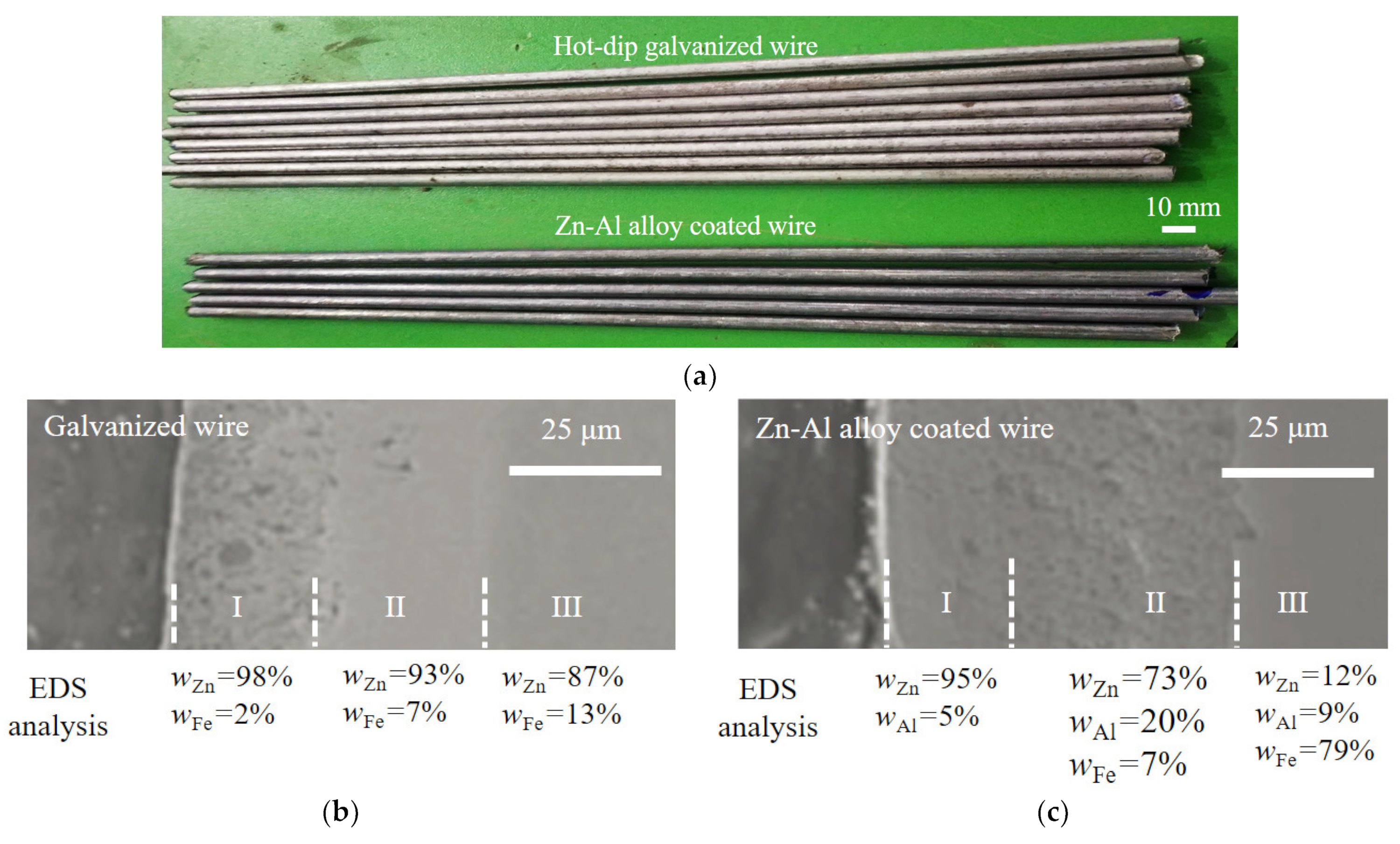

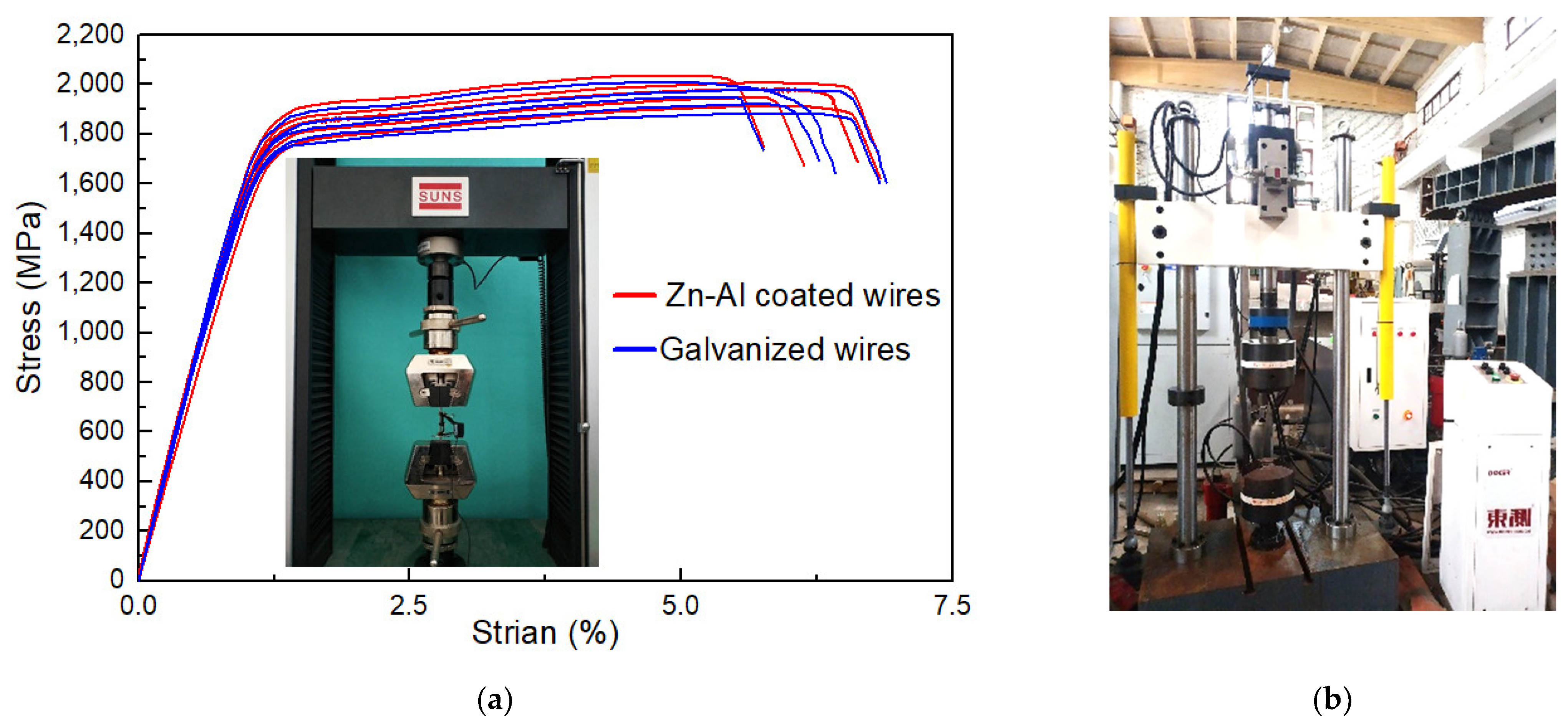

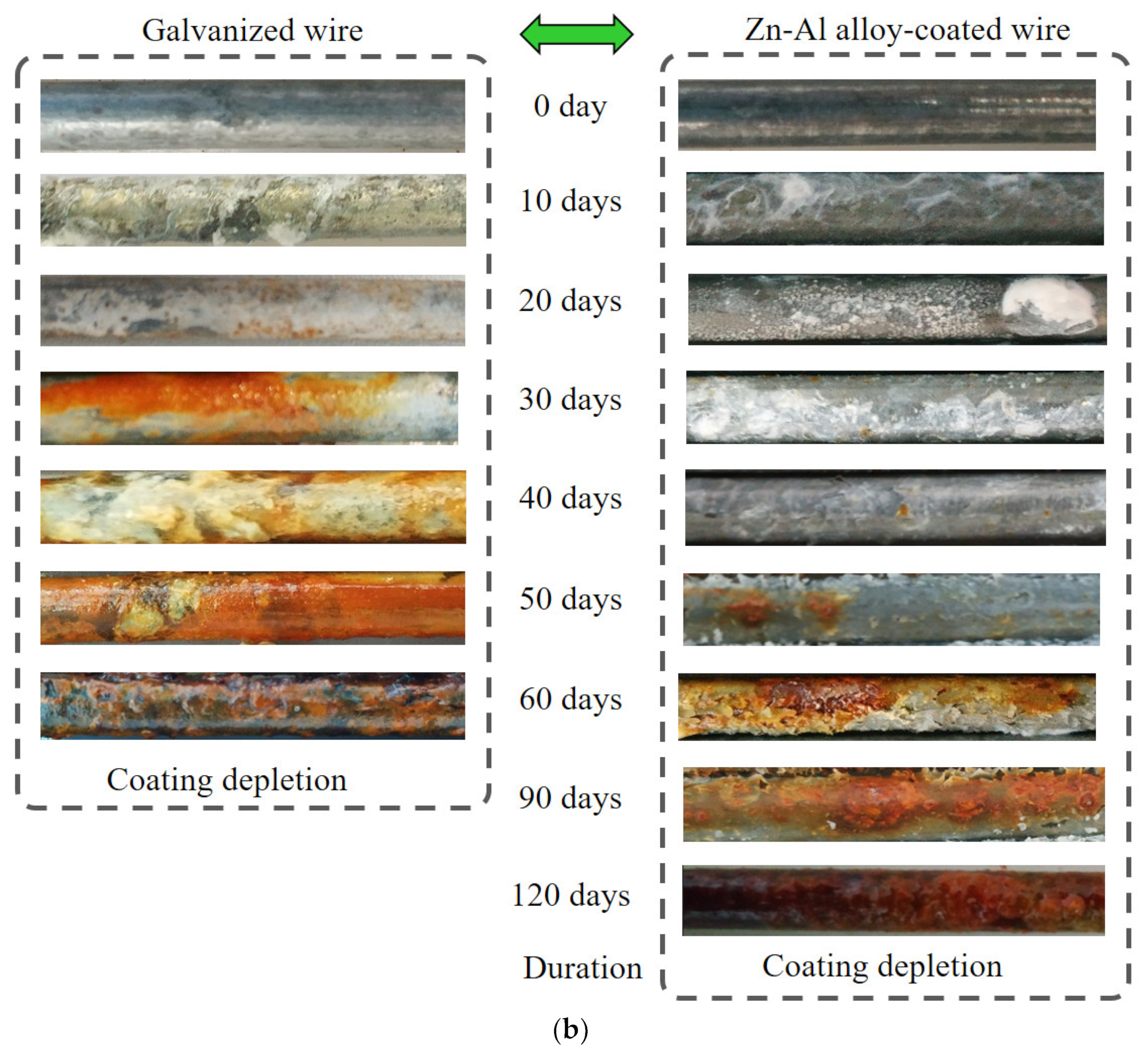



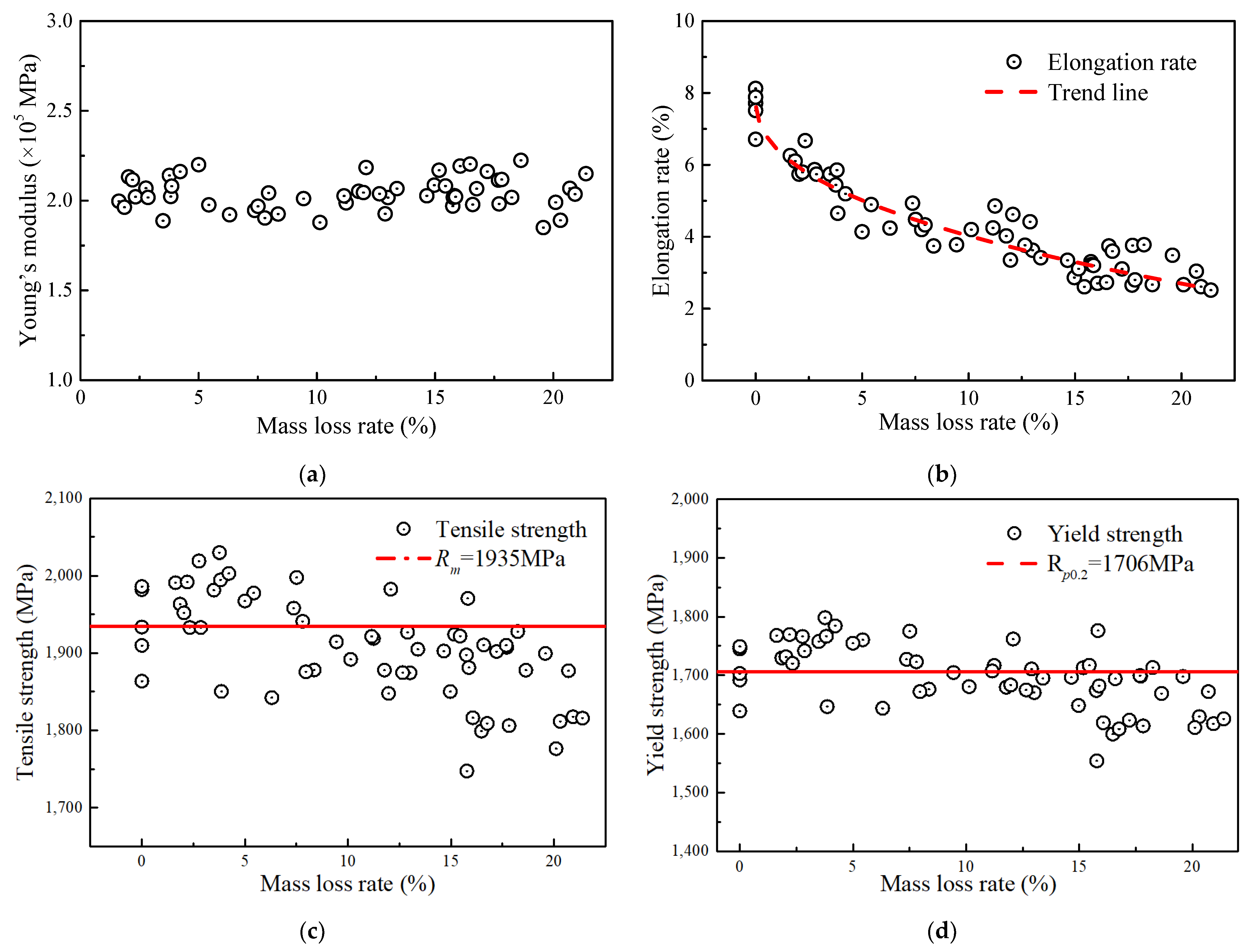
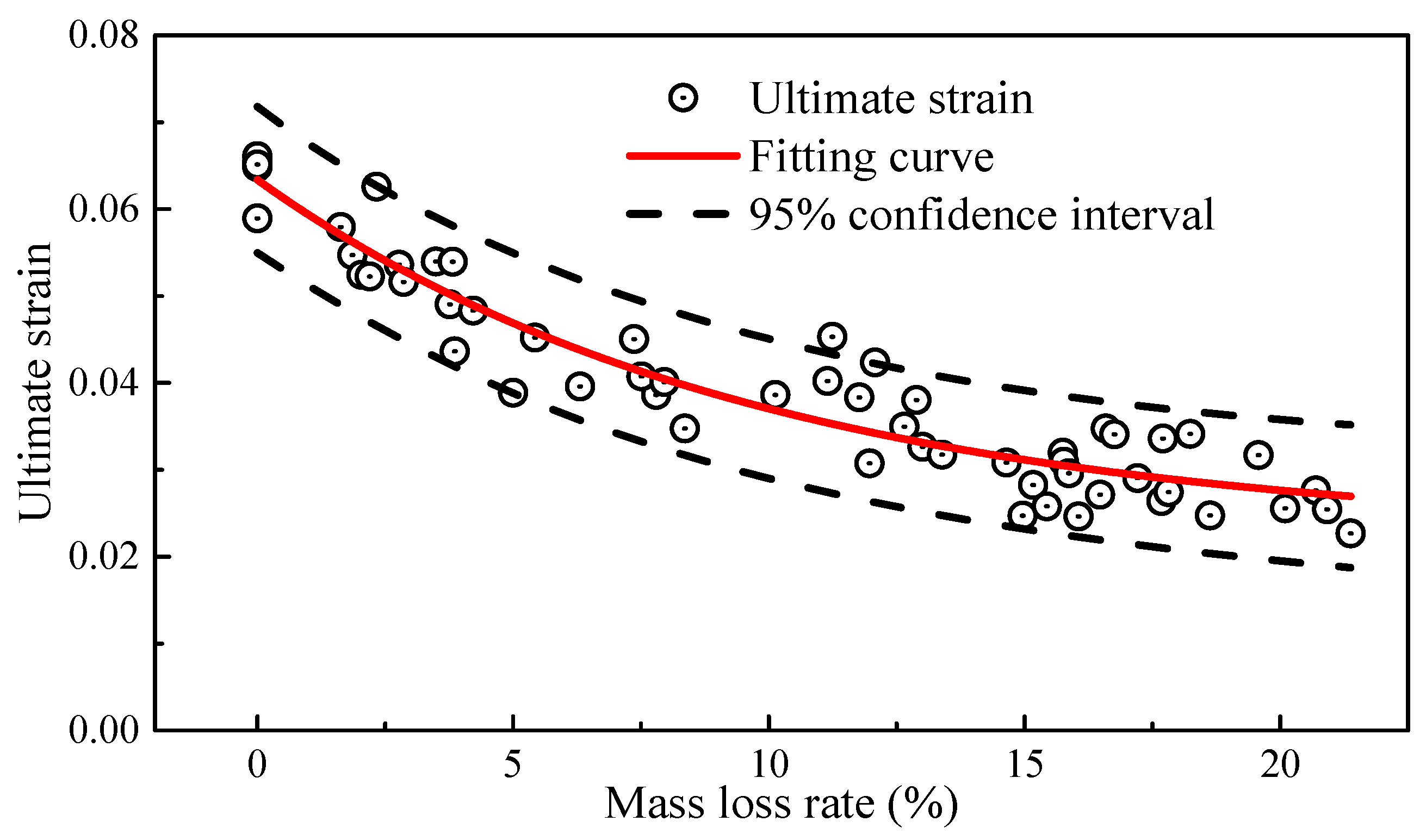
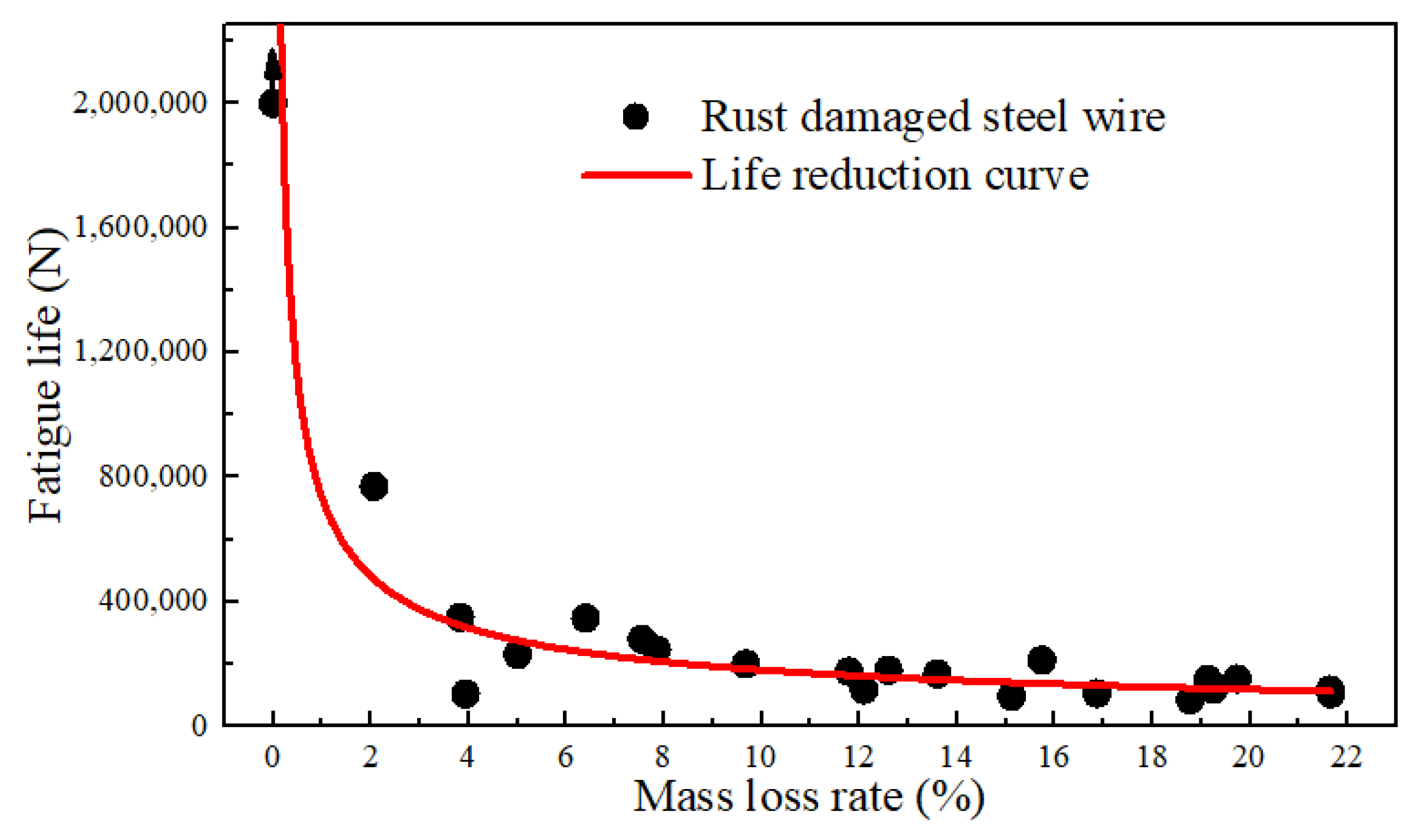
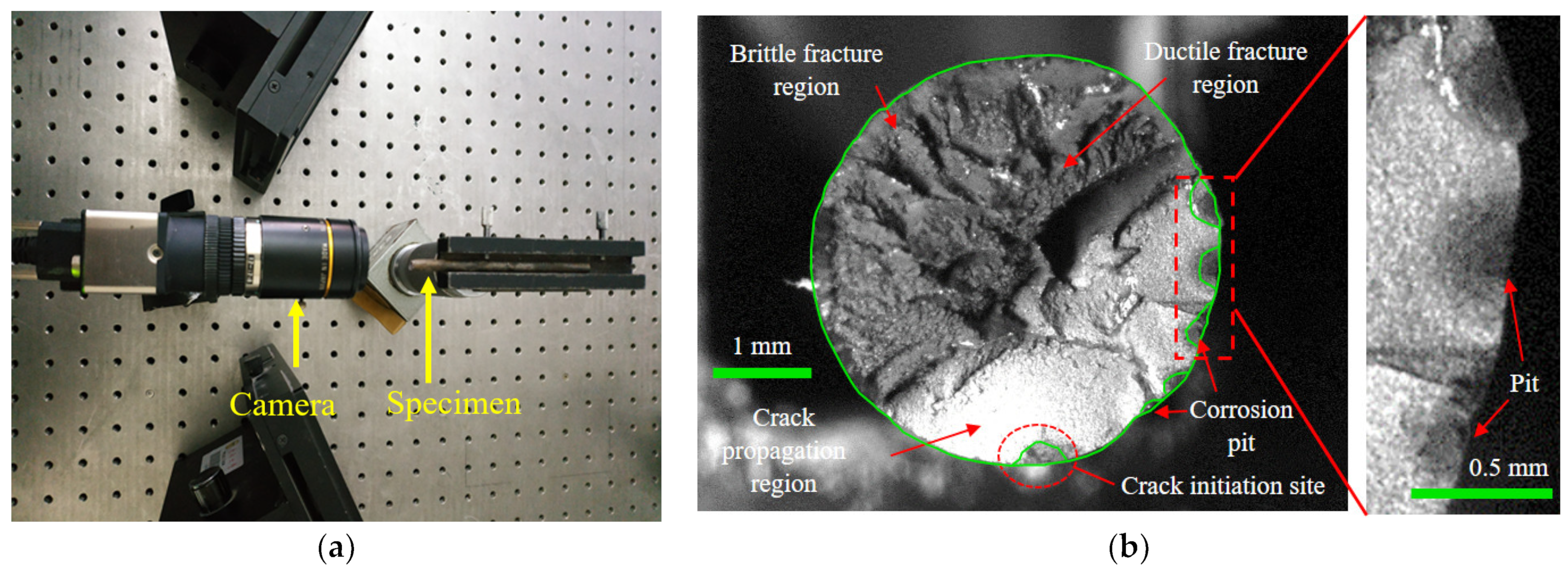
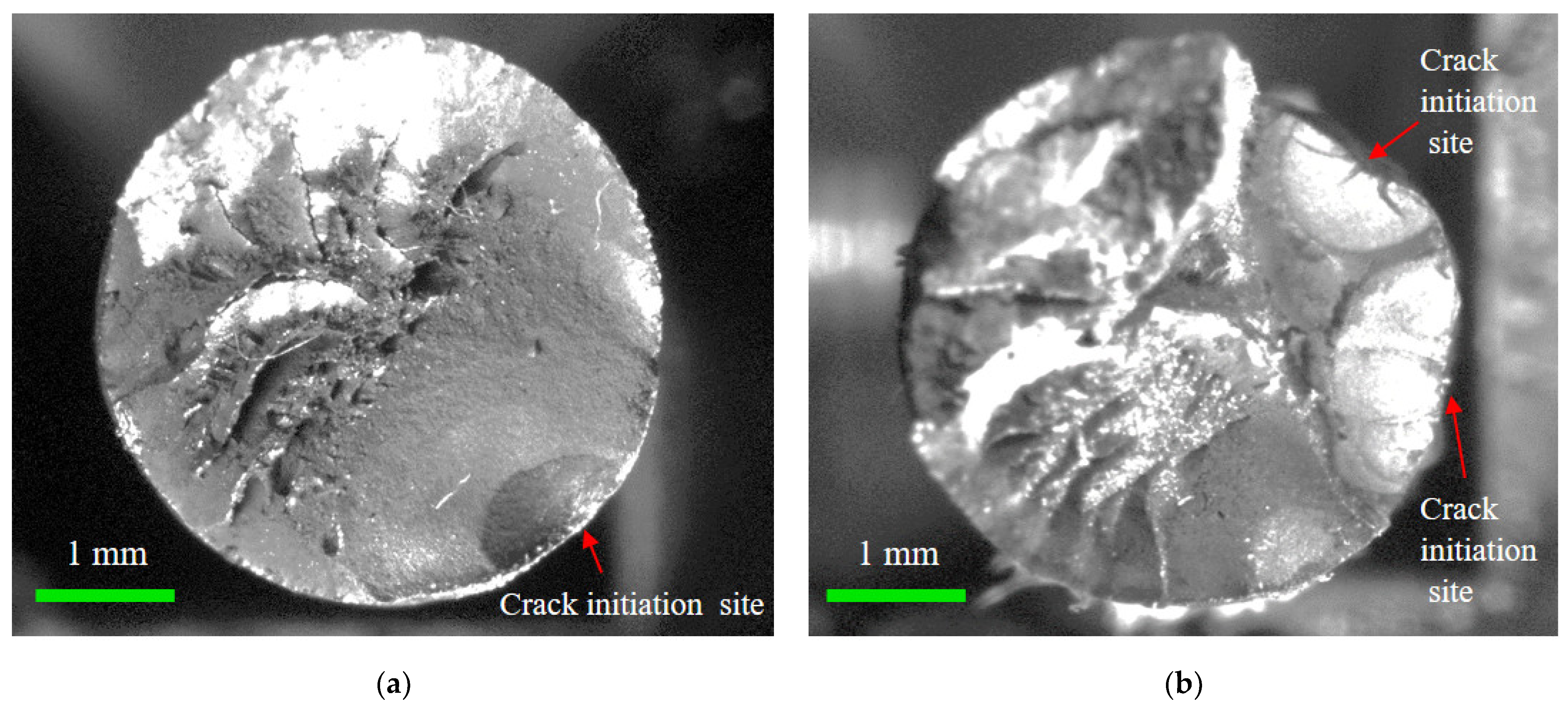
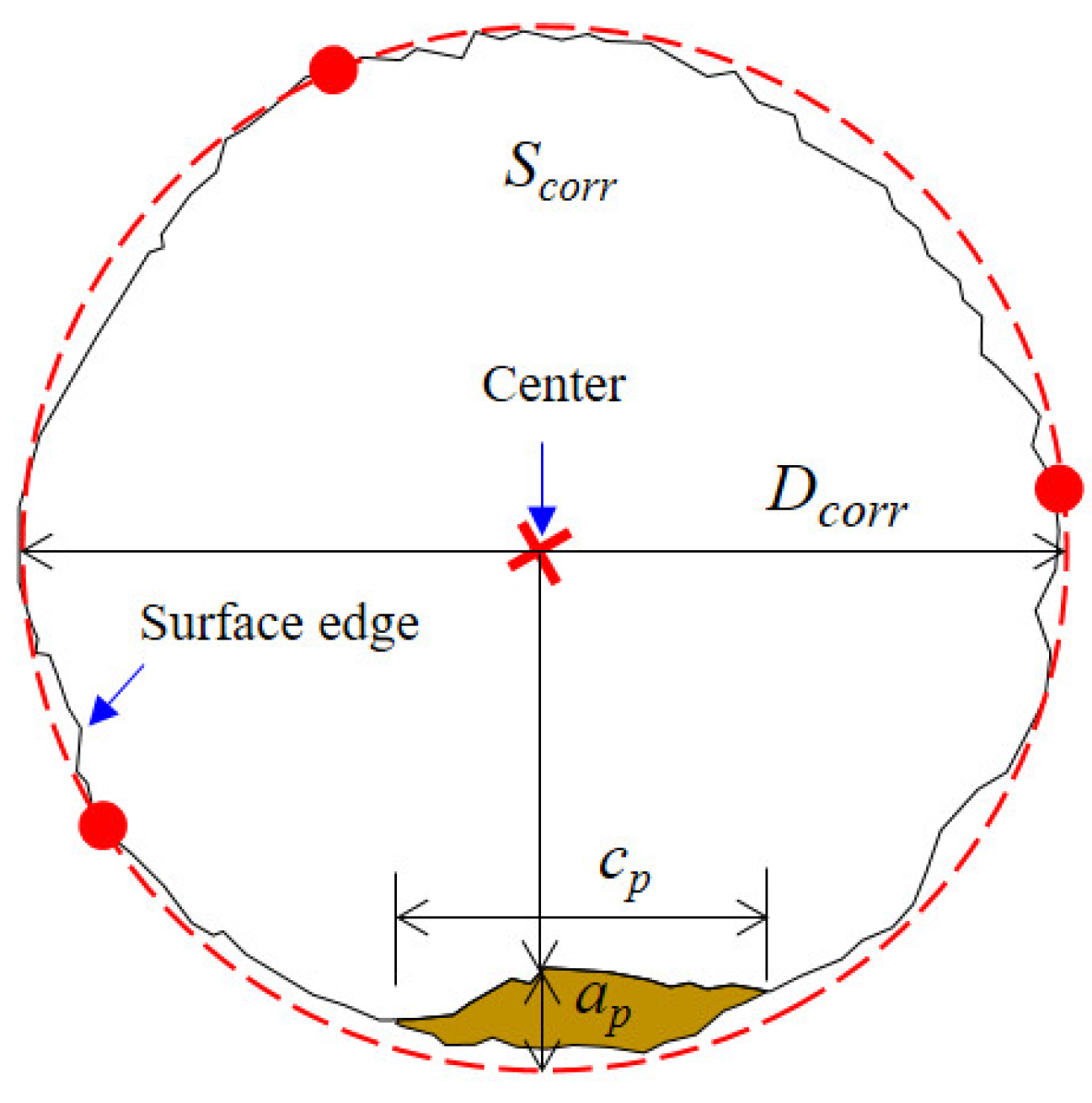
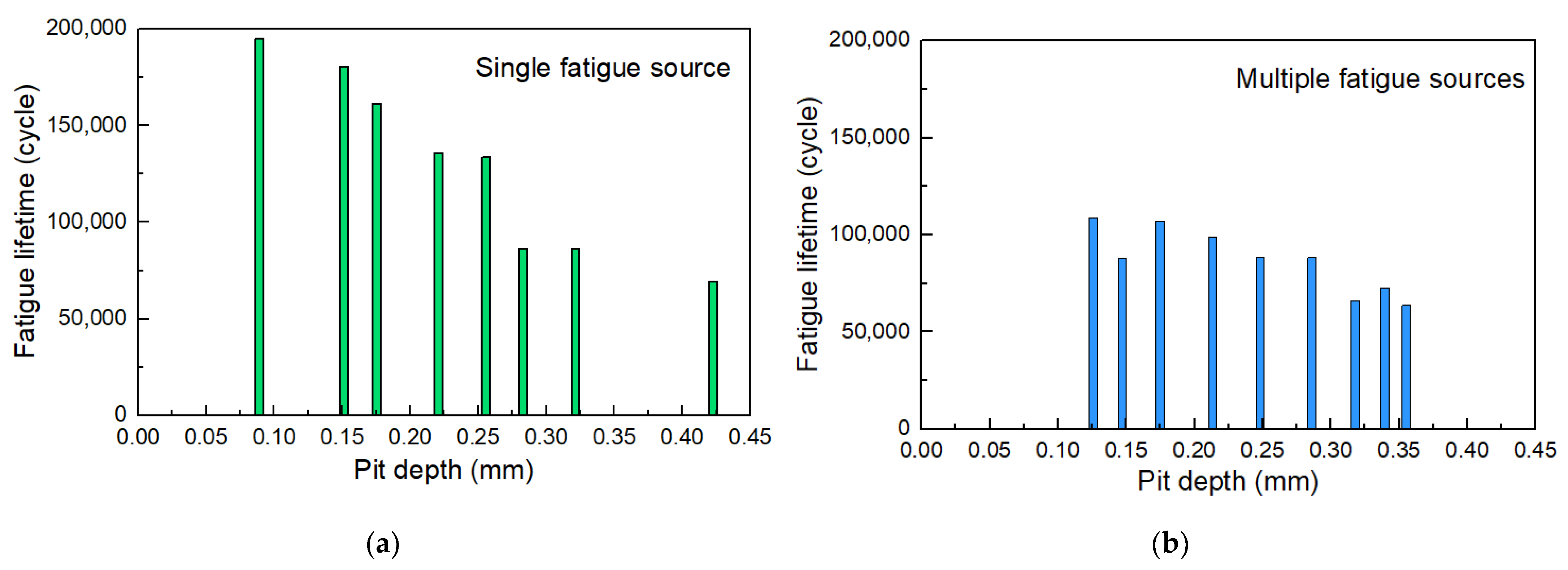
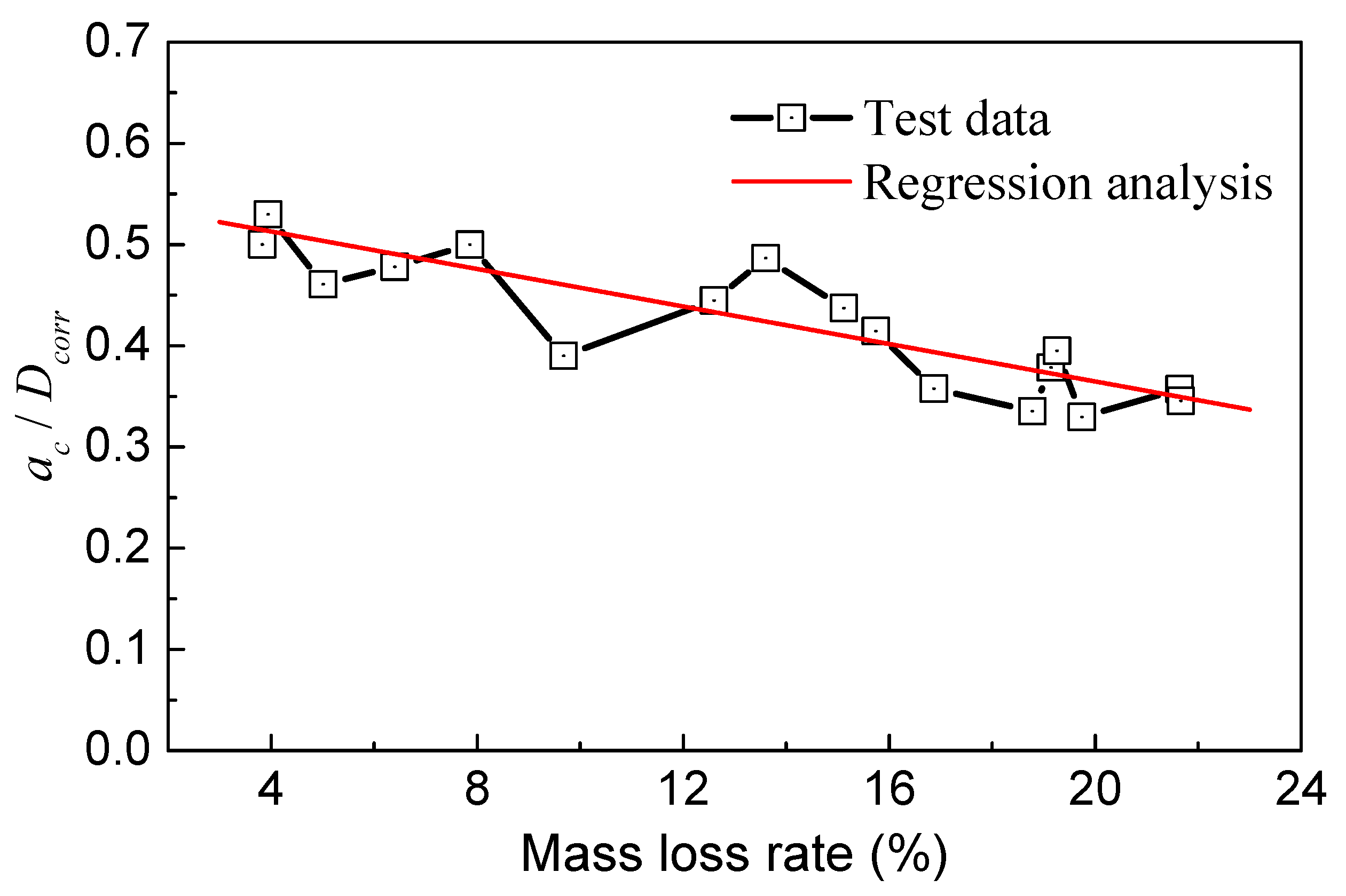

| Composition | Iron (Fe) | Carbon (C) | Silicon (Si) | Manganese (Mn) | Chromium (Gr) | Cuprum (Cu) | Sulfur (S) |
|---|---|---|---|---|---|---|---|
| Weight percent (%) | >98.0 | 0.8–0.85 | 0.15–1.00 | 0.60–0.90 | ≤0.20 | ≤0.06 | ≤0.025 |
| Wire Type | Tensile Strength (MPa) | Yield Strength (MPa) | Elongation Rate (%) | Elastic Modulus (GPa) |
|---|---|---|---|---|
| Galvanized | 1835 ± 67 | 1620 ± 64 | 6.8 ± 0.5 | 203 ± 23 |
| Zn-Al coated | 1935 ± 71 | 1706 ± 67 | 6.3 ± 0.5 | 204 ± 23 |
Disclaimer/Publisher’s Note: The statements, opinions and data contained in all publications are solely those of the individual author(s) and contributor(s) and not of MDPI and/or the editor(s). MDPI and/or the editor(s) disclaim responsibility for any injury to people or property resulting from any ideas, methods, instructions or products referred to in the content. |
© 2024 by the authors. Licensee MDPI, Basel, Switzerland. This article is an open access article distributed under the terms and conditions of the Creative Commons Attribution (CC BY) license (https://creativecommons.org/licenses/by/4.0/).
Share and Cite
Liu, Z.; Guo, T.; Li, W.; Zhang, Q.; Cheng, B.; Correia, J. Fatigue Behavior and Fracture Surface Analysis of Corroded High-Strength Bridge Cable Wires. Materials 2024, 17, 1724. https://doi.org/10.3390/ma17081724
Liu Z, Guo T, Li W, Zhang Q, Cheng B, Correia J. Fatigue Behavior and Fracture Surface Analysis of Corroded High-Strength Bridge Cable Wires. Materials. 2024; 17(8):1724. https://doi.org/10.3390/ma17081724
Chicago/Turabian StyleLiu, Zhongxiang, Tong Guo, Wenjie Li, Qinghua Zhang, Bin Cheng, and José Correia. 2024. "Fatigue Behavior and Fracture Surface Analysis of Corroded High-Strength Bridge Cable Wires" Materials 17, no. 8: 1724. https://doi.org/10.3390/ma17081724
APA StyleLiu, Z., Guo, T., Li, W., Zhang, Q., Cheng, B., & Correia, J. (2024). Fatigue Behavior and Fracture Surface Analysis of Corroded High-Strength Bridge Cable Wires. Materials, 17(8), 1724. https://doi.org/10.3390/ma17081724










